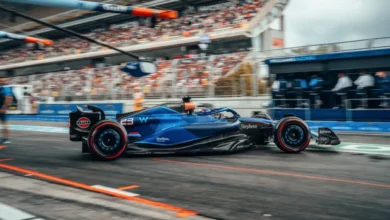Red Bull and Mercedes Lock Horns Over Proposed 2026 Formula 1 Regulations
A Clash of Perspectives: Technical Challenges and Differing Visions for F1's Future
In a recent exchange that highlights the intricate dynamics of Formula 1, Mercedes team principal Toto Wolff has taken aim at Red Bull for their divergent perspective regarding the forthcoming 2026 regulations in the sport. The Milton Keynes-based outfit, known for its assertive stance, has put forth a series of suggested revisions to the rules, triggering a clash of opinions within the F1 community.
Wolff’s assertion revolves around Red Bull’s purported discontentment with the trajectory of their 2026 engine development. According to Wolff, the team is advocating for rule modifications in response to its engine’s progression. However, these claims were swiftly debunked by Red Bull motorsport advisor Helmut Marko, who asserted that their collaboration with Ford has already yielded promising results in engine innovation. Marko further stated that Red Bull is significantly ahead of their competitors in shaping the new power unit.
Yet, lurking beneath the surface of this discourse is a complex technical intricacy. The regulatory framework dictates that the power output of the new F1 cars should be evenly divided – 50% from the internal combustion engine and an equal 50% from electric motors. This stipulation, as articulated by Marko, poses a nuanced challenge.
Addressing this matter from a logical standpoint, Marko outlined the inherent difficulty in achieving a battery’s doubled range while accounting for nearly half its weight. Consequently, the conventional 50:50 electric to internal combustion power distribution requires reevaluation. Marko advocates for an alternative approach involving E-fuels, suggesting a 60:40 ratio for the combustion engine. In his communication with Motorsport-Total.com, Marko expounded on this proposal.
“Every car manufacturer says that the battery will be half the weight and have twice the range in three years. But that’s not a fact.
“You would compensate for that with seven or ten percent less electrical system performance. We have e-fuels. We could switch the combustion engine to 60:40.”
Marko also brought to the fore another concern – the weight augmentation due to a substantial battery. He expressed apprehension that such weight increase could compromise the safety of the drivers. Furthermore, the prevailing lightweight nature of the cars would necessitate broader tracks to accommodate the additional mass. Marko articulated, “If lighter and smaller cars are the need of the hour then the new rules go against it.” He questioned the efficacy of a system that mandates 30 liters of fuel solely for battery charging, implying a misalignment in approach.
“The weight is a safety risk. The Silverstone accident that Max [Verstappen] had in 2021 can end very differently with such a heavy battery .
A battery always entails certain risks. We already have cars that are close to sports car level in terms of weight and size. But the racetracks remain the same. We would have to make them all a meter wider in order to keep up with the development of the cars.”
On a final note, Marko highlighted the potential obliteration of air resistance and the consequential elimination of the slipstream effect if the cars were made sleeker. While several other brands might share analogous concerns, it is Red Bull that has vocally raised its objections.
“[Frederic] Vasseur is continuing his love affair with Toto [Wolff].
“Therefore there is little resonance at Ferrari.”
In a lighthearted reference to the silence of other teams on these issues, Marko humorously cites Ferrari boss Frederic Vasseur. Notably, Vasseur had recently remarked that it was premature to be concerned about the 2026 regulations. In contrast, Marko conceded, “We don’t have any allies at the moment,” hinting at the possibility of others joining Red Bull in expressing their reservations.

